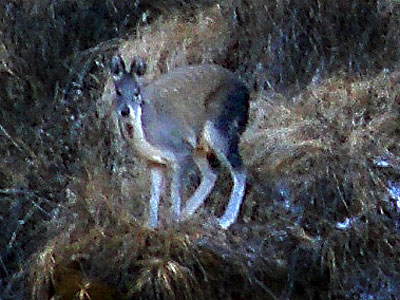
February 25, 2012
As reported last month in Katamundu, Nepal, a new musk deer has been discovered:

A new species of endangered Musk deer—differed from all three species found in the country—has been discovered in Mustang district.
Interestingly, the genetic testing (DNA test) conducted to identify the new species found that the gene sequence significantly differed from all other musk deer gene sequences in the global genetic database, indicating that the new member of the Musk deer family is a unique species discovered so far.
Two independent studies carried out in 2009 and 2011 by Paras Singh and Priya Joshi respectively have confirmed the presence of a unique species of musk deer near Lupra village in Mustang.
“The new species has brown body part with white portion towards the lower side and legs,” said Joshi, the researcher who used genetic tools on the pellets and tissue samples collected from Lupra village as a part of her Master thesis.
The other three Musk deer species found in Nepal are Moschus chrysogaster, Moschus leucogaster and Moschus fuscus. The musk deer are found in Nepal, China and India, Pakistan, Tibet and Mongolia.
According to Joshi, the collected samples were used during the lab test in Centre for Molecular Dynamics- Nepal in Kathmandu while the photograph taken by Singh were analysed by Dr Colin Groves, a leading taxonomist in Australia, who identified this unique species as the ‘pepper-and-salt’ variety alias ‘Kulu-form’ of musk deer.
“This is the first time that genetic tools have been used to identify a new species in Nepal,” she said. “We will now try to find out whether this new species matches the Kulu-form of musk deer found in Uttarkhand, India.”
“I am really excited to come across the new discovery. Though I sought to genetically identify the species of musk deer and their habitats in Mustang, the discovery of new species is something I had not expected to come across during the research work,” Joshi said.
Studies have also found that musk deer populations in Mustang face considerable threat from poaching as well as competition and habitat degradation from livestock, climate change and forest fires.
About Loren Coleman
Loren Coleman is one of the world’s leading cryptozoologists, some say “the” leading living cryptozoologist. Certainly, he is acknowledged as the current living American researcher and writer who has most popularized cryptozoology in the late 20th and early 21st centuries.
Starting his fieldwork and investigations in 1960, after traveling and trekking extensively in pursuit of cryptozoological mysteries, Coleman began writing to share his experiences in 1969. An honorary member of Ivan T. Sanderson’s Society for the Investigation of the Unexplained in the 1970s, Coleman has been bestowed with similar honorary memberships of the North Idaho College Cryptozoology Club in 1983, and in subsequent years, that of the British Columbia Scientific Cryptozoology Club, CryptoSafari International, and other international organizations. He was also a Life Member and Benefactor of the International Society of Cryptozoology (now-defunct).
Loren Coleman’s daily blog, as a member of the Cryptomundo Team, served as an ongoing avenue of communication for the ever-growing body of cryptozoo news from 2005 through 2013. He returned as an infrequent contributor beginning Halloween week of 2015.
Coleman is the founder in 2003, and current director of the International Cryptozoology Museum in Portland, Maine.
Filed under CryptoZoo News, New Species